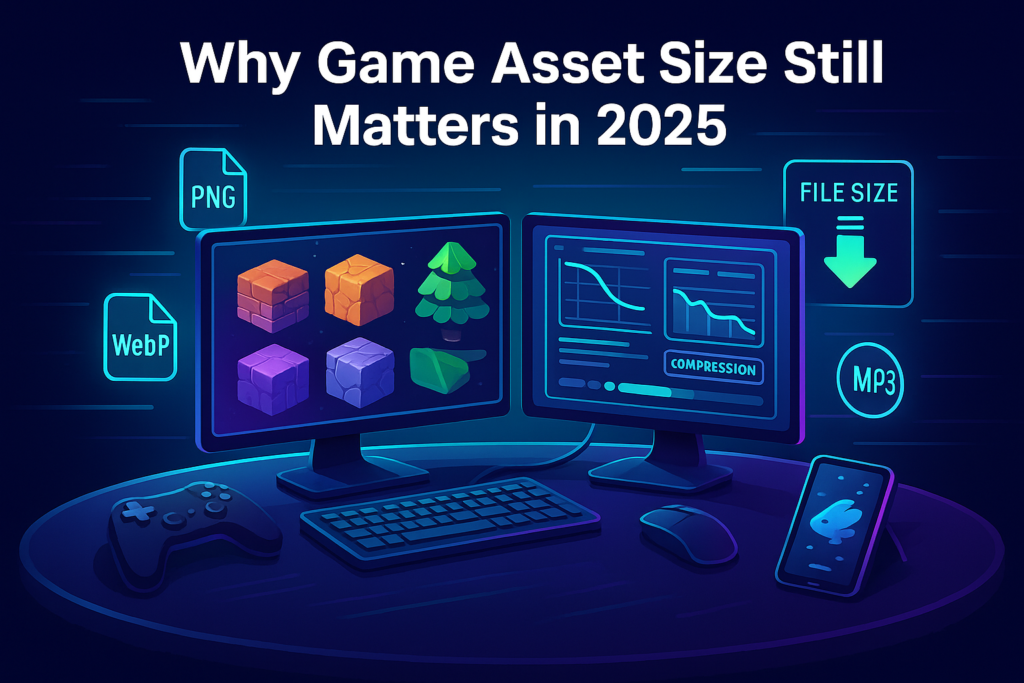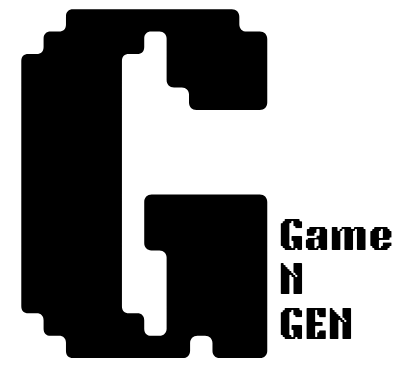By the GameNGen Editorial Team
Imagine launching your dream indie game in 2025. You’ve poured months into pixel-perfect sprites and epic soundtracks, only to see reviews tank with complaints like, “Too big, uninstalled after five minutes!” I’ve been there—my first mobile project a few years back hit 2.5GB post-launch, and half my early players dropped off due to storage woes. Even with fiber internet and beefy devices becoming the norm, game asset size remains a silent killer of user retention and app store rankings. So, why does every byte still matter in 2025, and how can we optimize without gutting quality? Let’s dive into the future of lean game design and unpack practical fixes that worked for me—and will for you too.

The Persistent Power of Small Files: Why Size Isn’t “Solved” Yet
You might think storage limits are ancient history with 1TB SSDs and 5G everywhere. But here’s the reality check I learned the hard way: size impacts far more than just downloads. As we push into 2025, here’s why asset bloat is still a battle worth fighting:
- Retention Through Speed: Players—especially on mobile—abandon games with long install times. A 2023 study by AppAnnie hinted that apps over 1GB lose 30% of potential users at download. By 2025, with mobile gaming booming in data-capped regions, this stat will likely worsen.
- Mobile and Budget Device Reality: Not everyone’s rocking a flagship phone. In emerging markets—projected to drive 70% of mobile game growth by 2025 per Statista—mid-range devices with 32GB storage are common. Big assets mean crashes or no installs at all.
- Performance Beyond Storage: Unoptimized textures and audio hog memory, tanking FPS. I’ve seen a 4K background sprite drop a test build from 60 to 25 FPS on a budget Android. Lighter files equal smoother play, fewer bugs, and happier reviewers.
Then there’s the cutting edge: VR headsets like the Meta Quest have tight onboard limits, and cloud gaming—set to explode by 2025—ties latency to asset streaming efficiency. Whether you’re coding for Steam, Google Play, or the next big platform, slimming down isn’t optional; it’s your edge.
Unpacking the Real Cost of “Just One More Texture”
Let me paint a picture from a side project I tinkered with in Unity last year. My 2D RPG started lean, but 120 raw PNG sprites at 2MB each added 240MB. Layer on 25 WAV tracks for ambiance—5MB apiece—and I’m at 365MB before scripts or mechanics. On a cheap test phone, load times dragged to 20 seconds, and memory spikes triggered random stutters. That’s not just numbers; it’s players bailing before level one.
Now, rework that math. Convert sprites to WebP at 80% quality (down to 400KB each), and audio to OGG at 128kbps (under 1MB per track). Suddenly, I’m at 73MB total—an 80% cut with visuals and sounds still crisp to the average eye and ear. That’s the difference between “unplayable” and “five stars.” Asset bloat isn’t a minor oops; it’s a direct hit to your game’s first impression. Let’s fix it.
Compression 101: Balancing Size and Soul in 2025
Compression isn’t just about squeezing files—it’s an art of trade-offs. I’ve spent hours tweaking settings to avoid muddy textures or tinny audio, and here’s the breakdown that guides me. By 2025, with AI upscaling in engines like Unreal becoming mainstream, these choices get even trickier.
- Lossy Compression (Smaller, Slight Trade-Off): Formats like JPG, AVIF, or OGG shrink files by trimming data. A background texture in AVIF might drop from 2MB to 200KB with minor artifacts most players won’t spot. Great for scenery or ambient tracks, less so for hero assets.
- Lossless Compression (Bigger, Perfect Fidelity): PNG or FLAC keep every detail, ideal for UI icons or critical sound effects. A logo in lossless WebP might stay at 600KB vs. 2MB uncompressed, but it’s still heavier than lossy options. Use when sharpness is non-negotiable.
Here’s my rule of thumb after trial and error: lossy for anything in the background (think grass tiles or looped music), lossless for what players stare at or hear on repeat (menus, voice lines). With AI tools predicted to enhance low-res assets by 2025, lossy might become your default sooner than you think. What’s your go-to format? I’m curious—hit the comments!
Hands-On Hacks: Slimming Assets Without Sacrificing Magic
I’m no AAA studio with endless budgets, so I’ve leaned on scrappy workflows to keep builds tight. Here’s my step-by-step for 2025-ready optimization, tested on real projects and budget hardware. No single “magic tool” here—just practical picks you can mix and match.
Images: Cut Size, Keep Clarity
- Resize First: If a sprite renders at 128×128 in-game, don’t ship a 1024×1024 source. I use GIMP (free) to batch-resize assets, slashing megabytes upfront.
- Pick Smart Formats: WebP or AVIF beat PNG for most uses. TinyPNG’s free online tool once dropped my 50-sprite folder by 65%—no blur, just savings.
- Tweak Quality Settings: For lossy, 75-85% quality often hides artifacts. Test on a low-end device; what looks fine on my laptop sometimes pixelates on a phone.
Audio: Trim Without Tinniness
- Ditch WAV for OGG or MP3: Background tracks at 128kbps sound fine—Audacity (free) converts in bulk. UI clicks? Mono over stereo cuts size by half.
- Chop Dead Air: Trim silence from intros or outros. I’ve shaved 20% off files just by snipping two-second pauses.
- Loop Efficiently: Export short clips with loop markers if your engine supports it. No need for a 5MB track repeating the same 10 seconds.
Test, Test, Test
Don’t guess—profile. I load builds on an old Samsung to catch lag spikes. Unity’s Profiler (or Unreal’s equivalent) exposes memory hogs. One rogue 4K texture once doubled my load time; spotting it pre-launch saved my sanity. What’s your testing setup like?
2025’s Cautionary Tale: Learning from Apex Legends Mobile’s Bloat Blunder
History offers brutal lessons, and Apex Legends Mobile’s 2022-2023 saga still stings. Launching at 1.5GB, it ballooned to over 8GB post-patches with uncompressed HD textures, duplicate assets, and multi-language audio packs. On mid-range phones—huge in markets like Asia and Latin America—it lagged, crashed, and ate storage. Reviews tanked with rants like “Unplayable on 64GB devices,” and retention plummeted. EA shuttered the game in May 2023, losing millions despite solid mechanics.
Here’s the 2025 takeaway: modular asset packs, adaptive downloads, and ruthless compression aren’t luxuries—they’re survival. With 5G enabling dynamic streaming by next year, imagine Apex splitting HD textures as optional for high-end users while serving lite packs to budget players. Indies like us can’t afford an 8GB misstep. Test across devices pre-launch, or risk an uninstall epidemic. What’s one big-file disaster you’ve dodged (or didn’t)?
Your Burning Questions, Answered (Let’s Chat!)
I’ve fielded plenty of asset woes at dev meetups, so let’s tackle common snags I hear—and face myself. Got others? Toss them in the comments; I’m all ears.
- Why does my game still lag after shrinking files? Size isn’t the only villain. Large textures can overload GPU memory, even compressed. Use profiling tools to hunt culprits—I caught a sneaky 8K skybox once with Unity’s built-in stats.
- Will compression ruin my visuals? Only if you overdo it. Stick to 80% quality for non-critical art and preview on target hardware. A muddy background is less noticeable than a fuzzy menu button.
- How do I handle audio without losing punch? Drop WAVs to OGG or MP3 at 96-128kbps for music. Keep key sounds (like explosions) at higher bitrates or lossless. Audacity lets me A/B test to hear the difference.
- What if users in low-data areas can’t download at all? By 2025, consider “lite” builds or cloud-streamed assets as 5G rolls out. Split non-essential files into optional packs—players appreciate the choice.
What’s your toughest optimization hurdle? Let’s swap fixes below!
Final Byte: Optimize Today for Tomorrow’s Players
As we head into 2025, game asset size isn’t a tech footnote—it’s your gateway to reaching players on beat-up phones, sleek VR rigs, or whatever’s next. I’ve seen firsthand how a bloated build kills hype, but also how a few smart cuts can turn “uninstalled” into “can’t put down.” Start small: audit one asset folder this week, play with free tools like GIMP or Audacity, and watch load times melt away. The reward? Players who stick around, rave reviews, and a game that fits everywhere.
What’s one compression trick you live by? Drop it in the comments—let’s build lighter, smarter games together for the future.
Why is my game build size so large even after optimization?
Many developers focus only on code and overlook assets like images and audio. High-resolution PNGs and uncompressed WAVs can balloon your project. Audit your asset folder — chances are, simple compression and resizing can reduce your build by 50% or more.
Will compressing game images make my graphics look bad?
Only if you overdo it or use poor-quality tools. With WebP or carefully tuned JPG compression, you can reduce size by up to 80% with almost no visible difference. Use preview-based compressors and test across devices before publishing.
How can I compress audio without killing the sound quality?
Switch from WAV to OGG or MP3, lower the bitrate (e.g., 128kbps), and use mono for simple effects. Tools like Audacity let you A/B test in real time. Don’t compress all audio blindly — music and UI sounds need different settings.
Why do my mobile game users complain about lag or crashes?
Often it’s due to memory overload from large textures and audio files. On mid-range phones, big assets can cause crashes or FPS drops. Compress assets smartly and always profile your build on low-end hardware before release.
Is it safe to use lossy compression for UI assets?
In most cases, no. UI assets like icons or text should be compressed losslessly (like WebP lossless or PNG). Artifacts in the UI hurt usability and UX trust. Use lossy only for backgrounds, particles, or scenery.
How do I know if I’ve over-compressed my assets?
Signs include pixelation, blurry edges, or audio that sounds “tinny.” The fix is simple: re-export at a slightly higher quality or switch to a different compression type. Always test on target platforms — what looks fine on desktop might fail on mobile.
try our tools
Game Mechanics Calculator
Helps calculate core game mechanics like damage scaling, XP progression, and physics-based values.
Game Asset Image Compressor
Optimizes image sizes (JPG, PNG, WebP) without sacrificing quality, perfect for reducing game asset sizes.
Latency Impact Visualizer
Shows the effects of latency across different regions (e.g., US East, EU Central) to help in multiplayer optimization.
Cloud Gaming Cost Estimator
Calculates expected cloud hosting costs for game servers on platforms like AWS, GCP, and Azure.
Reinforcement Learning Reward Calculator
Assists AI developers in setting and adjusting reward functions for training NPC behavior or game agents.
Quaternion Calculator
Performs quaternion math for rotations, including multiplication, normalization, and matrix conversions.
Vector Calculator
Calculates cross product, dot product, and magnitude—useful for 3D graphics and physics.
